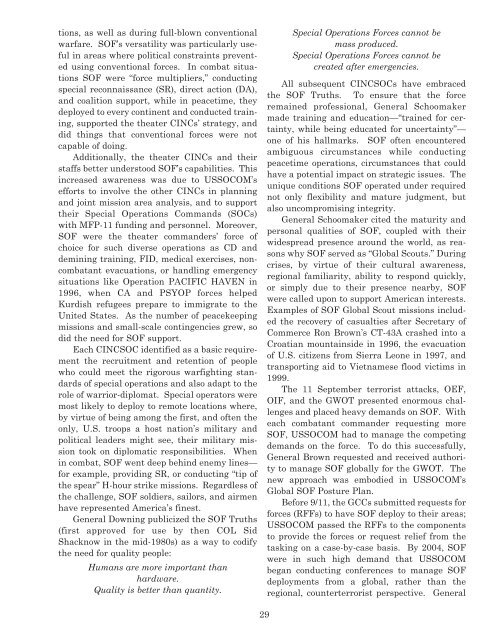HQ$History - United States Special Operations Command
HQ$History - United States Special Operations Command
HQ$History - United States Special Operations Command
You also want an ePaper? Increase the reach of your titles
YUMPU automatically turns print PDFs into web optimized ePapers that Google loves.
tions, as well as during full-blown conventional<br />
warfare. SOF’s versatility was particularly useful<br />
in areas where political constraints prevented<br />
using conventional forces. In combat situations<br />
SOF were “force multipliers,” conducting<br />
special reconnaissance (SR), direct action (DA),<br />
and coalition support, while in peacetime, they<br />
deployed to every continent and conducted training,<br />
supported the theater CINCs’ strategy, and<br />
did things that conventional forces were not<br />
capable of doing.<br />
Additionally, the theater CINCs and their<br />
staffs better understood SOF’s capabilities. This<br />
increased awareness was due to USSOCOM’s<br />
efforts to involve the other CINCs in planning<br />
and joint mission area analysis, and to support<br />
their <strong>Special</strong> <strong>Operations</strong> <strong>Command</strong>s (SOCs)<br />
with MFP-11 funding and personnel. Moreover,<br />
SOF were the theater commanders’ force of<br />
choice for such diverse operations as CD and<br />
demining training, FID, medical exercises, noncombatant<br />
evacuations, or handling emergency<br />
situations like Operation PACIFIC HAVEN in<br />
1996, when CA and PSYOP forces helped<br />
Kurdish refugees prepare to immigrate to the<br />
<strong>United</strong> <strong>States</strong>. As the number of peacekeeping<br />
missions and small-scale contingencies grew, so<br />
did the need for SOF support.<br />
Each CINCSOC identified as a basic requirement<br />
the recruitment and retention of people<br />
who could meet the rigorous warfighting standards<br />
of special operations and also adapt to the<br />
role of warrior-diplomat. <strong>Special</strong> operators were<br />
most likely to deploy to remote locations where,<br />
by virtue of being among the first, and often the<br />
only, U.S. troops a host nation’s military and<br />
political leaders might see, their military mission<br />
took on diplomatic responsibilities. When<br />
in combat, SOF went deep behind enemy lines—<br />
for example, providing SR, or conducting “tip of<br />
the spear” H-hour strike missions. Regardless of<br />
the challenge, SOF soldiers, sailors, and airmen<br />
have represented America’s finest.<br />
General Downing publicized the SOF Truths<br />
(first approved for use by then COL Sid<br />
Shacknow in the mid-1980s) as a way to codify<br />
the need for quality people:<br />
Humans are more important than<br />
hardware.<br />
Quality is better than quantity.<br />
<strong>Special</strong> <strong>Operations</strong> Forces cannot be<br />
mass produced.<br />
<strong>Special</strong> <strong>Operations</strong> Forces cannot be<br />
created after emergencies.<br />
All subsequent CINCSOCs have embraced<br />
the SOF Truths. To ensure that the force<br />
remained professional, General Schoomaker<br />
made training and education—“trained for certainty,<br />
while being educated for uncertainty”—<br />
one of his hallmarks. SOF often encountered<br />
ambiguous circumstances while conducting<br />
peacetime operations, circumstances that could<br />
have a potential impact on strategic issues. The<br />
unique conditions SOF operated under required<br />
not only flexibility and mature judgment, but<br />
also uncompromising integrity.<br />
General Schoomaker cited the maturity and<br />
personal qualities of SOF, coupled with their<br />
widespread presence around the world, as reasons<br />
why SOF served as “Global Scouts.” During<br />
crises, by virtue of their cultural awareness,<br />
regional familiarity, ability to respond quickly,<br />
or simply due to their presence nearby, SOF<br />
were called upon to support American interests.<br />
Examples of SOF Global Scout missions included<br />
the recovery of casualties after Secretary of<br />
Commerce Ron Brown’s CT-43A crashed into a<br />
Croatian mountainside in 1996, the evacuation<br />
of U.S. citizens from Sierra Leone in 1997, and<br />
transporting aid to Vietnamese flood victims in<br />
1999.<br />
The 11 September terrorist attacks, OEF,<br />
OIF, and the GWOT presented enormous challenges<br />
and placed heavy demands on SOF. With<br />
each combatant commander requesting more<br />
SOF, USSOCOM had to manage the competing<br />
demands on the force. To do this successfully,<br />
General Brown requested and received authority<br />
to manage SOF globally for the GWOT. The<br />
new approach was embodied in USSOCOM’s<br />
Global SOF Posture Plan.<br />
Before 9/11, the GCCs submitted requests for<br />
forces (RFFs) to have SOF deploy to their areas;<br />
USSOCOM passed the RFFs to the components<br />
to provide the forces or request relief from the<br />
tasking on a case-by-case basis. By 2004, SOF<br />
were in such high demand that USSOCOM<br />
began conducting conferences to manage SOF<br />
deployments from a global, rather than the<br />
regional, counterterrorist perspective. General<br />
29

















